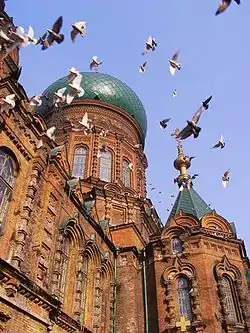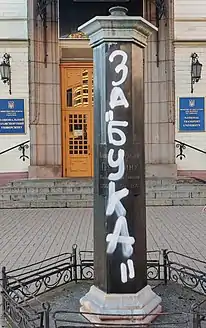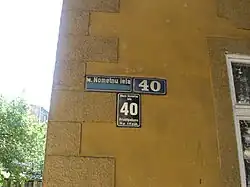Derussification (or derussianization) is a process or public policy in different states of the former Russian Empire and the Soviet Union or certain parts of them, aimed at restoring national identity of indigenous peoples: their language, culture and historical memory, lost due to Russification. The term can be also used to describe the marginalization of the language, culture and other attributes of the Russian-speaking society through the promotion of other, usually autochthonous, languages and cultures.
After the collapse of the Russian Empire
Early derussification processes manifested themselves in the newly independent states that emerged after the collapse of the Russian Empire in 1917, such as Poland, Finland, Georgia, Estonia, Latvia, and Lithuania.
Kars

After the Treaty of Moscow (1921) transferred the Kars Oblast and a number of adjacent territories to Turkey, almost all Christians, who made up 47% of the population according to the 1897 census, left these territories. The share of Slavs in the region, which at that time was 10.6% of the population (including 7.7% of Russians proper), dropped to a few thousand Spiritual Christians from Russia, most of whom returned to the Soviet Union in the mid-1920s and mid-1960s. The Greek, Armenian and Georgian communities ceased to exist.
Harbin Russians

In the period between 1945 and 1969, the derussification of Harbin ended, which at the peak of White emigration during the 1920s had an almost 300,000 Russian-speaking population in Northeast China. Most of the remaining Russian residents chose to migrate to the United States, Australia, or returned to the USSR.
In the Soviet Union
Korenizatsiia was an early policy of the Soviet government for the integration of non-Russian nationalities into the governments of their specific Soviet republics. In the 1920s, the policy promoted representatives of the titular nation, and their national minorities, into the lower administrative levels of the local government, bureaucracy, and nomenklatura of their Soviet republics. The main idea of the korenizatsiia was to grow communist cadres for every nationality. In Russian, the term korenizatsiia derives from korennoe naselenie (коренное население, "native population"). The policy practically ended in the mid-1930s with the deportations of various nationalities.[1][2]
By the mid-1930s, with purges in some of the national areas, the policy of korenizatsiia took a new turn, and by the end of the 1930s the policy of promoting local languages began to be balanced by greater Russianization. Moreover, Stalin seemed set on greatly reducing the number of officially recognized nationalities by contracting the official list of nationalities in the 1939 census, compared with the 1926 census. The term korenizatsiia went out of use in the latter half of the 1930s, replaced by more bureaucratic expressions, such as "selection and placement of national cadres" (подбор и расстановка национальных кадров). From 1937, the central press started to praise Russian language and Russian culture. Mass campaigns were organized to denounce the "enemies of the people". "Bourgeois nationalists" were new enemies of the Russian people which had suppressed the Russian language. The policy of indigenization was abandoned. In the following years, the Russian language became a compulsory subject in all Soviet schools.[3]
The pre-revolution Russian nationalism was also rehabilitated. Many of the heroes of Russian history were re-appropriated for glorification. The Russian people became the "elder brother" of the "Socialist family of nations". A new kind of patriotism, Soviet patriotism, was declared to mean a willingness to fight for the Socialist fatherland.[3] In 1938, Russian became a mandatory subject of study in all non-Russian schools. In general, the cultural and linguistic russification reflected the overall centralization imposed by Stalin. The Cyrillic script was instituted for a number of Soviet languages, including the languages of Central Asia that in the late 1920s had been given Latin alphabets to replace Arabic ones.
During the Soviet era, a significant number of ethnic Russians and Ukrainians migrated to other Soviet republics, and many of them settled there. According to the last census in 1989, the Russian 'diaspora' in the Soviet republics had reached 25 million.[4] Some historians evaluating the Soviet Union as a colonial empire, applied the "prison of nations" idea to the USSR. Thomas Winderl wrote "The USSR became in a certain sense more a prison-house of nations than the old Empire had ever been."[5]
Sino-Soviet Split
After the Sino-Soviet split, the Chinese Ministry of Public Security and the State Bureau of Surveying and Mapping in 1963 issued the document "Notice on Requesting Investigation and Research on Issues Existing in Russian Place Names and Proposing Handling Opinions", demanded Heilongjiang Province to derussify place names within its jurisdiction. Subsequently, the Heilongjiang Provincial Department of Civil Affairs conducted studies and identified 20 Russian place names that were used in the past but now have Chinese names (mainly streets in Harbin, and islands on Amur River) and 9 place names without Chinese names; then sent a written report to Beijing on December 27, 1963, containing suggestions for renaming Russian place names, as well as a note that some place names needed further study. On December 26, 1964, the State Council of the People's Republic of China approved the proposal for the derussification of place names.[6]
After the collapse of the Soviet Union
In most of the Central Asian and Transcaucasian republics of the former Soviet Union, the share and size of the Russian population fell particularly rapidly due to mass emigration, natural decline, and a prolonged population explosion among indigenous peoples who began to increase their presence in Russia as migrant workers.
Thus, in Tajikistan during the first ten years of independence, the number of Russians decreased from 400,000 to 60,000.[7] In 2010, the Russian language in the republic was deprived of the status of a language of interethnic communication. The rapid derussification of many other cities and regions of Kazakhstan and Central Asia continues.
For example, the share of the Russian population in Astana between 1989 and 2009 fell from 54.5% to 24.9%; in Almaty from 59.1% to 33.2%; in Bishkek from 55.8% to 26.1%.
Transition from the Cyrillic script
Since the collapse of the Soviet Union, the number of countries officially using the Cyrillic script shrank, which can also be considered a sign of derussification. The script ceased to be used in Azerbaijan, Moldova, Turkmenistan and partly in Uzbekistan. In Kazakhstan, a complete transition of the Kazakh language from Cyrillic to Latin is scheduled by 2025.[8]
By country
In Turkmenistan
All dedicated Russian-language schools were closed down, and their students sent to Turkmen schools across the country.[9] The Turkmen government reduced Russian-language instruction to one hour a week, blocked most Russian-language media, and later curtailed access to Russian-language material in the national library.[10]
In Kazakhstan
Kazakhstan used Latin letters from 1929 to 1940, after which the country switched to Cyrillic during a Stalinist reform. Before that, the Arabic script was used there.
On September 28, 2017, the Parliament of Kazakhstan held a hearing at which the draft of the new alphabet based on Latin was presented. The alphabet will consist of 25 characters. The project of the alphabet was presented by the director of the Coordination and Methodological Center of Language Development, Erbol Tleshev. According to him, the alphabet was compiled taking into account the language system of the Kazakh language and the opinions of experts. The Director of the Institute of Linguistics, Erden Kazybek, said that each letter of the alphabet will mean one sound and will not include additional graphic characters.[11]
On October 27, 2017, president Nursultan Nazarbayev signed a decree on the translation of the Kazakh alphabet from Cyrillic to Latin. The document, published on October 27, envisages a gradual transition to Latin graphics by 2025. The decree also approved a new alphabet.[12]
On February 26, 2018, during a meeting with the Minister of Information and Communications, Dauren Abayev, President of Kazakhstan Nursultan Nazarbayev ordered to translate the activities of the state authorities exclusively into the Kazakh language. This transition will take place in stages.[13]
In Moldova
Moldova was annexed into the USSR as the Moldavian SSR following the Soviet-German Molotov–Ribbentrop Pact in 1940. Soon after, the language of the country was renamed from "Romanian" to "Moldavian" and it ceased being written in the Latin alphabet, changing to Cyrillic. This policy would only be reversed in 1989, after large demonstrations imbued with patriotic feeling.[14] Romanian is an official language in the Constitution of Moldova since its independence, and it is Moldova's sole official language today.[15] Russian is still in use but not as important as it was in the Soviet era, since it has no special status in the country and its usage as mother tongue has been declining for some time.[16][17][18]
In Ukraine

Derussification in Ukraine began in the aftermath of the Collapse of the Soviet Union in 1991, when Ukraine became independent. However, in their first years after independence, decommunisation, and the creation of a free market capitalist economy took precedent. However, the processes of derussification and decommunisation are intimately linked, and some key steps were made spontaneously and unsystematically.[19] As of 2022, the decommunisation process is largely complete within Ukraine, and so more energies have been devoted recently to derussification. This process was compounded and accelerated by the escalation in the Russo-Ukrainian War starting with the Russian invasion of Ukraine in February 2022.[20]
Against the background of the invasion, de-Russification began in earnest in Ukraine. Street names were changed and Soviet-Russian monuments were demolished in villages and towns.[21] Changes were made in Lviv, Dnipro,[22] Kyiv[23] and Kharkiv. In turn, Ivano-Frankivsk became the first city in Ukraine to be completely free of Russian names.[24]
As of April 8, 2022, according to a poll by the sociological group Rating, 76% of Ukrainians support the initiative to rename streets and other objects whose names are associated with Russia or the Soviet Union.[25][26]
On 21 April 2023, President Volodymyr Zelenskyy signed the Law of Ukraine "On Condemnation and Prohibition of Propaganda of Russian Imperial Policy in Ukraine and Decolonization of Toponymy".[27] This law prohibits toponymy that symbolizes or glorifies Russia, individuals who carried out aggression against Ukraine (or another country), as well as totalitarian policies and practices related to the Russian Empire and the Soviet Union, including Ukrainians living in Russian-occupied territories.[27]
In the Baltic states

The Baltic states (Lithuania, Latvia and Estonia) have undergone derussification since regaining independence from the Soviet Union in 1991. Occupation of the Baltic states resulted in a significant ethnic Russian minority, who, almost without exception, spoke only Russian.[28] Derussification efforts began with switching the language of official business from Russian to the local Baltic languages, and restoring traditional nationality and citizenship laws. In parallel with the situation in Ukraine, however, more effort was devoted to decommunization than to derussification in the early years of independence.[19]
The Russian invasion of Ukraine accelerated derussification in the Baltic states. One change of note was the Latvian decision to convert all existing public schools to Latvian-only, beginning in September 2023.[29] While policies have previously been in place to encourage the use of Latvian over Russian in education settings, these rules were inconsistently enforced and schools were not monitored. All public schools in Latvia will use Latvian as the language of education by September 2025.[29]
See also
References
- ↑ Nicolaïdis, Kalypso; Sebe, Berny; Maas, Gabrielle (2014-12-23). Echoes of Empire: Memory, Identity and Colonial Legacies. Bloomsbury Publishing. ISBN 978-0-85773-896-7 – via Google Books.
Elsewhere in the USSR, the late 1930s and the outbreak of World War II also saw some significant changes: elements of korenizatsiya were phased out... the Russians were officially anointed as the 'elder brothers' of the Soviet family of nations, whilst among historians Tsarist imperialism was rehabilitated as having had a 'progressive significance'
- ↑ Chang, Jon K. "Tsarist continuities in Soviet nationalities policy: A case of Korean territorial autonomy in the Soviet Far East, 1923-1937". Eurasia Studies Society of Great Britain & Europe Journal.
- 1 2 Timo Vihavainen: Nationalism and Internationalism. How did the Bolsheviks Cope with National Sentiments? in Chulos & Piirainen 2000, p. 85.
- ↑ Pål Kolstø, "Political construction sites: Nation-building in Russia and the post-Soviet States". Boulder, Colorado: Westview press 2000, pp. 81–104 uncorrected version, Chapter 2, par. "Nations and Nation-Building in Eastern Europe" Archived 19 December 2017 at the Wayback Machine and Chapter 5 Archived 2 January 2005 at the Wayback Machine
- ↑ Bekus, Nelly (2010-01-01). Struggle Over Identity: The Official and the Alternative "Belarusianness". Central European University Press. p. 42. ISBN 978-963-9776-68-5.
- ↑ Зуенко Иван Юрьевич (2018). "Исчезнувший образ: топонимика русского происхождения в провинции Хэйлунцзян и Автономном районе Внутренняя Монголия КНР" (PDF). Известия Восточного института (in Russian). doi:10.24866/2542-1611/2018-2/85-98.
- ↑ http://tsgi.rtsu-slavist.tj/index-11.html%5B%5D
- ↑ Bulambayeva, Aigerim (2017-10-31). "Kazakhstan to switch to Latin alphabet by 2025". The Astana Times. Retrieved 2022-04-19.
- ↑ "Turkmenistan: Blow for Russian-Speakers". IWPR. Retrieved 21 February 2005.
- ↑ "Turkmenistan at Twenty-Five: The High Price of Authoritarianism". Carnegie Endowment for International Peace. Retrieved 30 January 2017.
- ↑ "A project of a new alphabet based on Latin was presented in Kazakhstan". Портал мовної політики (in Ukrainian). 2017-09-28. Retrieved 2022-04-19.
- ↑ "Kazakhstan opens new Latin alphabet to public opinion". www.aa.com.tr. Retrieved 2022-04-19.
- ↑ "Kazakhstan abandons the Russian language in favor of the state language". Портал мовної політики (in Ukrainian). 2018-02-27. Retrieved 2022-04-19.
- ↑ Erizanu, Paula (27 August 2021). "The Literary-musical Clubs that Sparked the Moldovan National Liberation Movement 30 Years Ago". Retrieved 22 April 2023.
- ↑ "Moldova officially identifies its national language as Romanian". Romania Insider. 3 March 2023. Retrieved 22 April 2023.
- ↑ Chinn, Jeffrey. "The Politics of Language in Moldova" (PDF).
- ↑ "Moldovan court overturns special status for Russian language". Reuters. Retrieved 22 January 2021.
- ↑ "Population and Housing Census in the Republic of Moldova, May 12-25, 2014". National Bureau of Statistics of the Republic of Moldova. 2 August 2013. Retrieved 22 April 2023.
- 1 2 Denysova, Katia (2022). "Decolonisation, De-Communisation and De-Russification of the Ukrainian Cultural Space". Immediations. The Courtauld Institute of Art (22). Retrieved 2023-05-01.
- ↑ Philp, Catherine. "On the front line of Ukraine's cultural de-Russification". The Times. ISSN 0140-0460. Retrieved 2023-05-01.
- ↑ Rad, Taras. "Derusification of consciousness or Ukrainian narration of urban space". Istorychna Pravda. Retrieved 2022-04-22.
- ↑ "In the Dnipro, about 30 streets were renamed, the names of which were associated with Russia" (in Ukrainian). Ukrinform. Retrieved 2022-04-22.
- ↑ ""The derussification of the Kyiv metro is part of the resistance": an interview with a historian about the new names of stations" (in Ukrainian).
- ↑ "Without Marshal Zhukov and Moscow streets. A new wave of decommunization and derussification has begun in Ukraine". The New Voice of Ukraine (in Ukrainian). Retrieved 2022-04-22.
- ↑ "76% of Ukrainians support renaming streets and other objects related to Russia". Nikopol.City (in Ukrainian). Retrieved 2022-04-22.
- ↑ "Eight National Poll: Ukraine in War Conditions" (in Ukrainian). April 6, 2022.
- 1 2 "Zelenskyy signs law banning geographical names associated with Russia". Ukrayinska Pravda. 21 April 2023. Retrieved 21 April 2023.
- ↑ Alijeva, Lilija (2017). "Left Behind? A Critical Study of the Russian-speaking Minority Rights to Citizenship and Language in the Post-Soviet Baltic States. Lessons from Nationalising Language Policies". International Journal on Minority and Group Rights. 24 (4): 484–536. doi:10.1163/15718115-02404004. ISSN 1385-4879. JSTOR 26557930.
- 1 2 "Latvia to gradually transition to education only in official language". Baltic News Network. LETA. 2022-09-29. Retrieved 2023-05-01.